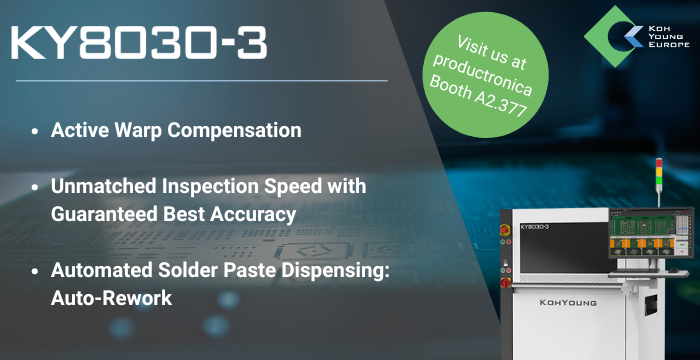
How to deal with semiconductor excess inventory
After allocation comes excess inventory. The panic buying of recent years, combined with strict terms from manufacturers and distributors have led to massive inventory buildups. So, how to get rid of excess smartly?
Author: Georg Steinberger

Not by spreading your part lists worldwide! Exclusive marketing and intelligent filters are the much better option, says Mike Sigrist, Managing Director of excess specialist Unisolution, in a recent interview with Georg Steinberger, industry veteran, trade journalist and supply chain advocate.
Georg Steinberger: Mr. Sigrist, what is the best way to deal with excess inventory, left over from the last allocation, without discounting all the devices that were acquired expensively?
Mike Sigrist: The worst thing you can do is to spread your lists of excess components across the planet and hope you can achieve a good price. The wider and the more often you show your offering, the less you will get. I understand the pressure to reduce working capital levels, but the result of the above will be higher depreciation. My advice to sellers would be to focus on exclusivity, to position the highlights in your list and, if possible, to do this with an eye on industry segmentation. This requires a bit more patience.
Georg Steinberger: How does this cycle differ from previous ones, from an excess perspective?
Mike Sigrist: We are looking at a much bigger variety of excess components than in previous cycles, because nearly all manufacturers and products have been affected by allocation, all the excess orders have indeed been manufactured. Suppliers and distributors have applied strict NCNR (not cancellable, not returnable) rules to protect themselves, so customers are now sitting on a mountain of inventory of nearly everything, that they want to dispose of, if they can’t consume it in their production.
Georg Steinberger: With a global components market of 800 billion dollars – semiconductors represent nearly 550 billion of that -, how big do you think is the excess market?
Mike Sigrist: As we are looking at a very different post-allocation situation than in the past, my estimation is between 50 and 100 billion US dollars, worldwide, way beyond normal. At a customer level, we are talking about twice the normal inventory level, on average, about 50% of the annual demand. At manufacturers the situation is similar. Parts of it can be consumed through existing end customer orders, but the current low market situation suggests that roughly 10% remain as excess market.
Georg Steinberger: Sounds like a lot. Where can you sell all this?
Mike Sigrist: When you go to the usual online platforms, the impression of excess is potentially worse, because the same goods are offered multiple times. Independents and dealers are involved, too. Undoubtedly the biggest market potential is in Asia, the idea of buying excess inventory is more common than in Europe or the US. However, you should not expect these channels to deliver good prices. Another hot topic, at least in Europe and the USA, is obsolescence.
Georg Steinberger: Please elaborate.
Mike Sigrist: In the last allocation, little precautions were taken, and several manufacturers have obsoleted more components than usual, for understandable reasons. The result is that many customers are increasingly missing the right components. During the allocation, OEMs and EMS companies threw their resources at alternative products and requalification; new designs to circumvent obsolescence fell short. Sure, there are specialists for obsolete components, supported by many suppliers, but they can only serve the tip of the iceberg. For excess specialists like Unisolutions, this remains a recurring topic.
Georg Steinberger: Are counterfeit products a major issue at this point?
Mike Sigrist: The problem was bigger during allocation, but it is a constant nuisance that seemingly cannot be eliminated. The only solution is 100% transparency in the supply chain. Customers need to know exactly the source of their components.
Georg Steinberger: What is easiest to sell in the excess market?
Mike Sigrist: It depends on your marketing model, but in general the high-end components run best – high-end memory, CPUs, MCUs etc. At a more specific level, it depends on how well an excess specialist understands the various market segments, how well product filters work and so on. Software and tools are important, too, but experience and reputation make the difference, as well as a transparent business model. If customers as well as the sellers of excess – the latter ones are OEMs and EMS companies – get the idea that someone does cherry picking – “I win, you lose”, that would not be a good fundament for doing business.
Georg Steinberger: What is your suggestion at Unisolution?
Mike Sigrist: We position ourselves as excess service provider and not as a classic distributor. Therefore, we apply three different models: 1. We buy customer goods at our own risk, the customer writes-off the goods and stays out of the further process. For the customer this model normally has the lowest yield, it is how brokers work. 2. We take customer goods in consignment, and they stay in the customers’ balance sheet until the sale. The turnover is shared in a predefined scheme. 3. We also offer a hybrid model, whereby we buy at a low price and the customer writes-off at the low value. The risk is with us, but we offer a profit-sharing scheme, in which the customer can reduce his depreciation requirement. The total package defines which model we apply, with the customer interests in mind.
Georg Steinberger: Are there any additional legal aspects to consider when selling excess inventory?
Mike Sigrist: Of course, you must respect warranty rules and provide utmost traceability, we would never buy from dubious sources. All this is in the contracts, like customers deal with their end customers. We rely on customer infrastructures for quality and physical tests, and in cases of doubt, we also initiate inspections ourselves.
Georg Steinberger: Which roles do suppliers and classical distributors play in that context?
Mike Sigrist: Manufacturers are normally not active in this market, as they have contractual obligations to their partners and their primary goal is to sell new components. Distributors do this at a very limited scale, with well-known and reliable partners, but not in a scalable business model.
Georg Steinberger: What happens if China floats the market with cheap semiconductors?
Mike Sigrist: I assume this may be more an issue for the components manufacturers and their new products than for the excess market. However, in the future, it could affect us, to, if certain products will not be in demand anymore.
Georg Steinberger: Famous last words?
Mike Sigrist: In dealing with excess, the key is transparency.



